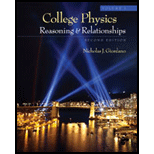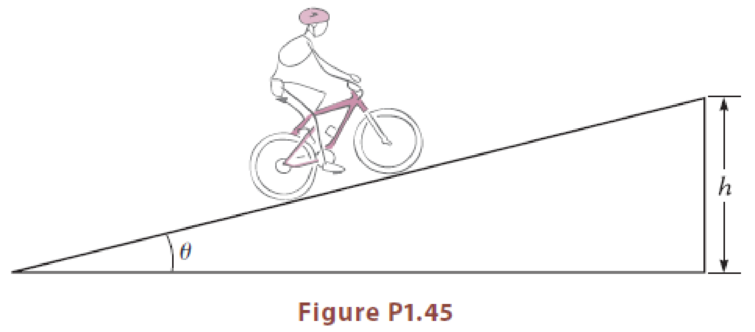
College Physics, Volume 1
2nd Edition
ISBN: 9781133710271
Author: Giordano
Publisher: Cengage
expand_more
expand_more
format_list_bulleted
Textbook Question
Chapter 1, Problem 45P
Steep grade. A mountain road makes an angle θ = 8.5° with the horizontal direction (Fig. P1.45). If the road has a total length of 3.5 km, how much does it climb? That is, find h.

Expert Solution & Answer
Want to see the full answer?
Check out a sample textbook solution
Students have asked these similar questions
Figure E1.28
y
В (15.0 m)
D (10.0 m)
30.0°
53.00
25.0°
Č (12.0 m)
A (8.00 m)
3. Given the vectors on Fig E1.28:
a. Find the components of each
vector. Express your answers in î , ĵ,
and k notation.
L74. A sailor in a small sailboat encounters shifting winds. She
sails 2.00 km east, then 3.50 km southeast, and then an additional
distance in an unknown direction. Her final position is 5.80 km
directly east of the starting point (Fig. 1.39). Find the magnitude
Figure 1.39 Problem 1.74.
STAKT
FINISH
5.80 km-
Jas.0
45.0°
2.00 km
3.50
Third
leg
km
Suppose you went for a drive along a long, straight road that runs east-west. Let's define east to be the positive x direction.
From your home, you drive east at 30. mi/hr to your friends house for 20. minutes, then at 48 mi/hr east for 10. minutes to the grocery store. Finally, you drive west at 60. mi/hr without stopping to get home.
How many minutes will it take to drive from the grocery store to your home (at 60. mi/hr)?
Note: Your answer should have the correct number of significant figures
Chapter 1 Solutions
College Physics, Volume 1
Ch. 1.3 - Give the number of significant figures for all the...Ch. 1.4 - Prob. 1.2CCCh. 1.5 - The area of a surface can be measured in units of...Ch. 1 - Suppose a friend told you that the density of a...Ch. 1 - Prob. 2QCh. 1 - Prob. 3QCh. 1 - Prob. 4QCh. 1 - Prob. 5QCh. 1 - Prob. 6QCh. 1 - Prob. 7Q
Ch. 1 - Prob. 8QCh. 1 - Prob. 9QCh. 1 - Prob. 1PCh. 1 - You take a long walk on a sandy beach. When you...Ch. 1 - Prob. 3PCh. 1 - Prob. 4PCh. 1 - Prob. 5PCh. 1 - Prob. 6PCh. 1 - Prob. 7PCh. 1 - Prob. 8PCh. 1 - Prob. 9PCh. 1 - Prob. 10PCh. 1 - Prob. 11PCh. 1 - Prob. 12PCh. 1 - Prob. 13PCh. 1 - Prob. 14PCh. 1 - Prob. 15PCh. 1 - Prob. 16PCh. 1 - Prob. 17PCh. 1 - Prob. 18PCh. 1 - Prob. 19PCh. 1 - Prob. 20PCh. 1 - Prob. 21PCh. 1 - Prob. 22PCh. 1 - Prob. 23PCh. 1 - Prob. 24PCh. 1 - Prob. 25PCh. 1 - Prob. 26PCh. 1 - Prob. 27PCh. 1 - Prob. 28PCh. 1 - Prob. 29PCh. 1 - Consider the equation mgh=12mv2 where m has units...Ch. 1 - Prob. 31PCh. 1 - Prob. 32PCh. 1 - Prob. 33PCh. 1 - Prob. 34PCh. 1 - Prob. 35PCh. 1 - Prob. 38PCh. 1 - Prob. 39PCh. 1 - Prob. 40PCh. 1 - Prob. 41PCh. 1 - Prob. 42PCh. 1 - Prob. 43PCh. 1 - Prob. 44PCh. 1 - Steep grade. A mountain road makes an angle = 8.5...Ch. 1 - Prob. 46PCh. 1 - Prob. 47PCh. 1 - Prob. 48PCh. 1 - Prob. 49PCh. 1 - Prob. 50PCh. 1 - Prob. 52PCh. 1 - Prob. 53PCh. 1 - Prob. 54PCh. 1 - Prob. 55PCh. 1 - Prob. 56PCh. 1 - Prob. 57PCh. 1 - Prob. 58PCh. 1 - Prob. 59PCh. 1 - Prob. 60PCh. 1 - Prob. 61PCh. 1 - Prob. 62PCh. 1 - The unit of area called the acre comes from an old...Ch. 1 - Prob. 64PCh. 1 - Prob. 65PCh. 1 - Prob. 66PCh. 1 - Prob. 67PCh. 1 - Prob. 68PCh. 1 - Prob. 69PCh. 1 - Prob. 70PCh. 1 - Prob. 71PCh. 1 - Prob. 72PCh. 1 - Prob. 73PCh. 1 - Prob. 74PCh. 1 - Prob. 75P
Knowledge Booster
Learn more about
Need a deep-dive on the concept behind this application? Look no further. Learn more about this topic, physics and related others by exploring similar questions and additional content below.Similar questions
- A person going for a walk follows the path shown in Figure P1.51. The total trip consists of four straight-line paths. At the end of the walk, what is the persons resultant displacement measured from the starting point? Figure P1.51arrow_forwardFigure P1.6 shows a frustum of a cone. Match each of the three expressions (a) (r1 + r2)[h2 + (r2 r1)2]1/2, (b) 2(r1 + r2), and (c) h(r12 + r1r2 + r22)/3 with the quantity it describes: (d) the total circumference of the flat circular faces, (e) the volume, or (f) the area of the curved surface. Figure P1.6arrow_forwardA jet airplane reaches 679./kmh on a certain flight. What distance does it cover in 6.0min? Set the math up. But don't do any of it. Just leave your answer as a math expression. Also, be sure your answer includes all the correct unit symbols.arrow_forward
- shown in Fig. resultant displacement by 1.28 for a different approach.) Figure E1.21 2.6 km START 800 4.0 km STOP 3.1 km 45° 1.22. For the vectors A and B Figure E1.22 Fig. E1.22, use a scale drawing to find the magnitude and direction of (a) the vector sum A + B and (b) the vector difference A - B. Use your answers to find the magnitude and direction of (c) - A - B and (d) B-A. (See also Exercise 1.29 for a different approach.) 1.23 A spelunker is surveying a cave. She follows a passage 180 m straight west, then 210 m in a di- rection 45° east of south, and then 280 m at 30° east of north. After a fourth displacement, she finds her- self back where she started. Use a scale drawing to determine the mag- nitude and direction of the fourth displacement. (See also Problem 1.57 for a different approach.) W-E Ď (10.0 m) 25.0° Ć (12.0 m) y 53.00 B (15.0 m) 30.0° 0 X A (8.00 m) Section 1.8 Components of Vectors 1.24 Let be the angle that the vector A makes with the +x- axis, measured…arrow_forward1.28..For the vectorsAandBin Fig. E1.28, use a scaledrawing to find the magnitudeand direction ofarrow_forwardA force F, of magnitude 6.00 units acts on an object at the origin in a direction 0 = 30.0° above the positive x-axis (Fig. P1.58). A second force É2 of magnitude 5.00 units acts on the object in the direction of the positive y-axis. Find graphically the magnitude and direction of the resultant force F, + F2. Figure P1.58arrow_forward
- For the triangle shown in Figure P1.45, what are (a) thelength of the un known side, (b) the tangent of θ, and (c) thesine of ϕ?arrow_forward1.3). Jisoo drives 5.25 km, 25° W of N, then 2.50 km, 65° S of W, and then 1.50 km, 345° w/ respect to the +x-axis. Find the magnitude and direction of the resultant displacement, using the method of components.arrow_forwardFor the vectors A and B in Fig. E1.22e, use a scale drawing to find the magnitude and direction of (a) the vector sum A+B and (b) the vector difference A-B. Use your answers to find the magnitude and direction of (c) - A - Band (d) B - A. (See also Exercise 1.29 for a different approach.)arrow_forward
- While exploring a cave, a spelunker starts at the entrance and moves the following distances: 71.5 m north, 90.1 m east, 57.3 m at an angle 30.0° south of east, and 28.3 m south. Find the magnitude of the resultant displacement from the cave entrance in meters. Round your answer to 2 decimal places.arrow_forward71. A commuter airplane starts from an airport and takes the route shown in Figure P1.71. The plane first flies to city A, located 175 km away in a direction 30.0° north of east. Next, it flies for 150. km 20.0° west of north, to city B. Finally, the plane flies 190. km due west, to city C. Find the location of city C relative to the location of the starting point. t 1 y (km) 250 E N C W E 200 20.0° 150 R 100 110° a 50 30.0° x (km) 50 100 150 200 Figure P1.71arrow_forwardPaleontologists use the function W(x) = 4√/2x to estimate the walking speed of a dinosaur, W(x), in feet per second, where x is the length, in feet, of the dinosaur's leg. What is the walking speed of a dinosaur whose leg length is 6 feet? Express the answer in simplified radical form. Then use the function's graph to estimate the answer to the nearest foot per second. Walking speed (feet per second) feet per second. (Round to the nearest whole number as needed.) Dinosaur Walking Speeds W(x) = 4√2x Write the walking speed of a dinosaur whose leg length is 6 feet as a simplified radical. feet per second. (Simplify your answer. Type an exact answer, using radicals as needed.) Use the graph to estimate the walking speed of a dinosaur whose leg length is 6 feet. Leg length (feet) [0.25,1] by [0,30,2] Q Qarrow_forward
arrow_back_ios
SEE MORE QUESTIONS
arrow_forward_ios
Recommended textbooks for you
 Principles of Physics: A Calculus-Based TextPhysicsISBN:9781133104261Author:Raymond A. Serway, John W. JewettPublisher:Cengage Learning
Principles of Physics: A Calculus-Based TextPhysicsISBN:9781133104261Author:Raymond A. Serway, John W. JewettPublisher:Cengage Learning

Principles of Physics: A Calculus-Based Text
Physics
ISBN:9781133104261
Author:Raymond A. Serway, John W. Jewett
Publisher:Cengage Learning
Components of a Vector (Part 1) | Unit Vectors | Don't Memorise; Author: Don't Memorise;https://www.youtube.com/watch?v=fwMUELxZ0Pw;License: Standard YouTube License, CC-BY
02 - Learn Unit Conversions, Metric System & Scientific Notation in Chemistry & Physics; Author: Math and Science;https://www.youtube.com/watch?v=W_SMypXo7tc;License: Standard Youtube License